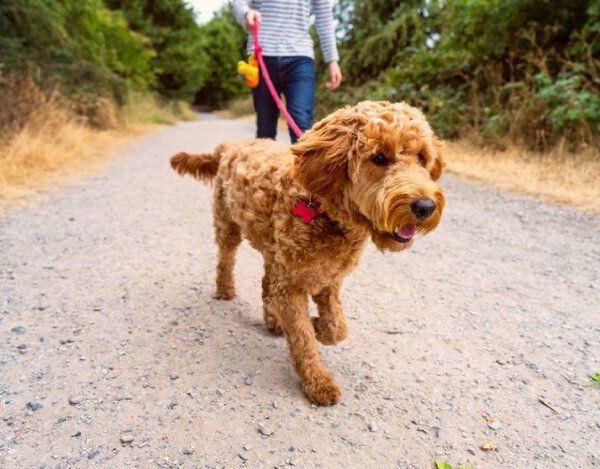The Fundamentals of Leash Training
How To Teach Your Dog To Walk With A leash
A leash walk is a valuable skill for your dog, making outings more enjoyable for both of you. By understanding the fundamentals and applying the right approach, you can guide your furry friend towards becoming a polite and well-mannered walking companion. Prior to beginning this training journey, it is important to invest in some quality equipment to make training successful:
- Collar or Harness: Choose a comfortable option that fits securely. Consider a front-clip harness to discourage pulling.
- Leash: A 4-6 foot leash is ideal. Avoid retractable leashes, as they can contribute to pulling behavior.
- High-Value Treats: Small, tasty treats that your dog loves will be your reward currency.
To train a dog to walk beside you, practice tiny steps on leash in a small, quiet space and treat them whenever they move along with you. Gradually work up to different areas of your home, larger steps and fewer treats, until they eventually learn to walk beside you while on leash. The foundation of successful leash training lies in positive reinforcement. Rewarding desired behaviors, such as walking calmly beside you, reinforces the association between good behavior and positive outcomes. By using high-value treats as rewards, you can motivate your dog to focus on you and resist distractions. While positive reinforcement is
Speak With A Dog
Training Expert
Speak With A Dog Training Expert
Thank you for contacting us!
We will contact you shortly!
Please try again later.
A Well Exercised Dog Is A Well Behaved Dog
Did you know that insufficient exercise can lead to various behavioral issues in dogs such as destructive chewing, digging, excessive barking, hyperactivity, and attention-seeking behaviors? It's crucial to ensure your dog's needs for exercise and social interaction are met before leaving them alone or confining them. When a dog leaves a sedentary lifestyle, there are several common behavioral issues that may arise:
Excessive barking: Under-exercised dogs may bark excessively out of boredom or frustration.
Destructive behavior: Without an outlet for their energy, dogs may resort to destructive behaviors like chewing furniture or digging holes.
Aggression: Pent-up energy can manifest as aggression towards other dogs or people.
Anxiety: Dogs who don't get enough exercise may develop anxiety or other stress-related behaviors.
Speak With A Dog
Training Expert
Speak With A Dog Training Expert
Thank you for contacting us!
We will contact you shortly!
Please try again later.
essential, it's also important to address distractions effectively. If your dog becomes distracted by other dogs, people, or objects, use verbal cues and gentle leash corrections to redirect their attention. Remember, patience and consistency are key. Don't expect immediate results, and be prepared to adjust your training approach as needed.
As your dog's leash walking improves, you can gradually increase the distance between treats. This helps maintain their focus and encourages them to stay close to you. Additionally, varying your walking routes can help your dog generalize their training and perform well in different environments.
You might be wondering, what is it about exercise that helps improve a dog’s behavior? Physical activity is essential for dogs' well-being. It helps them release pent-up energy, reduce stress, and experience a sense of fulfillment. Exercise not only benefits their physical health but also positively impacts their behavior. When dogs engage in physical activity, they can release pent-up energy, preventing boredom and restlessness. Additionally, activities like agility training, fetch, or scent work stimulate their minds, providing mental enrichment. Exercise also offers excellent bonding opportunities for dogs and their owners. Shared activities like hiking, playing fetch, or swimming strengthen the bond and create positive associations.
Moreover, regular exercise often involves social interactions with other dogs and people. This socialization helps improve a dog's social skills and reduces the likelihood of behavioral issues like aggression or fearfulness.


Exercising Your Dog for Corpus Christi Dog Training
To create an effective exercise routine for your dog, consider their individual preferences and needs. Choose activities they enjoy, whether it's fetch, running, or agility training. Consistency is key, so establish a regular routine and stick to it. To prevent boredom, mix up the activities and rotate between walking, running, hiking, swimming, and interactive games. The type and amount of exercise a dog needs depends on its breed and individual needs. Breeds bred for specific tasks, like herding or retrieving, often have higher energy levels and require more intense exercise. For instance, retrievers might enjoy long games of fetch, while herding breeds may thrive on training and agility exercises. A good rule of thumb is that dogs should engage in at least 30 minutes to 2 hours of physical activity each day. This range depends heavily on the breed and individual needs of the dog as mentioned above. For instance, an adult Labrador might thrive on an
Exercising Your Dog for Corpus Christi Dog Training
To create an effective exercise routine for your dog, consider their individual preferences and needs. Choose activities they enjoy, whether it's fetch, running, or agility training. Consistency is key, so establish a regular routine and stick to it. To prevent boredom, mix up the activities and rotate between walking, running, hiking, swimming, and interactive games. The type and amount of exercise a dog needs depends on its breed and individual needs. Breeds bred for specific tasks, like herding or retrieving, often have higher energy levels and require more intense exercise. For instance, retrievers might enjoy long games of fetch, while herding breeds may thrive on training and agility exercises. A good rule of thumb is that dogs should engage in at least 30 minutes to 2 hours of physical activity each day. This range depends heavily on the breed and individual needs of the dog as mentioned above. For instance, an adult Labrador might thrive on an hour of exercise daily, while a Pug might be perfectly content with 30 minutes. The goal is to provide a balanced exercise routine that keeps your dog physically and mentally healthy, without overexerting them. Remember, quality time and enrichment activities are just as important as physical exercise.
Exercise is a fundamental tool in managing and preventing behavioral issues. A tired dog is often a well-behaved dog. Physical activity not only expends excess energy, preventing destructive behaviors like chewing or digging, but it also provides mental stimulation. This mental stimulation can significantly reduce stress and anxiety, leading to calmer and more focused dogs. So, the next time you’re wondering why your furry friend is acting up, consider whether they’ve had enough physical and mental exercise. Remember, a well-exercised dog is a happy, well-adjusted dog.
hour of exercise daily, while a Pug might be perfectly content with 30 minutes. The goal is to provide a balanced exercise routine that keeps your dog physically and mentally healthy, without overexerting them. Remember, quality time and enrichment activities are just as important as physical exercise.
Exercise is a fundamental tool in managing and preventing behavioral issues. A tired dog is often a well-behaved dog. Physical activity not only expends excess energy, preventing destructive behaviors like chewing or digging, but it also provides mental stimulation. This mental stimulation can significantly reduce stress and anxiety, leading to calmer and more focused dogs. So, the next time you’re wondering why your furry friend is acting up, consider whether they’ve had enough physical and mental exercise. Remember, a well-exercised dog is a happy, well-adjusted dog.
